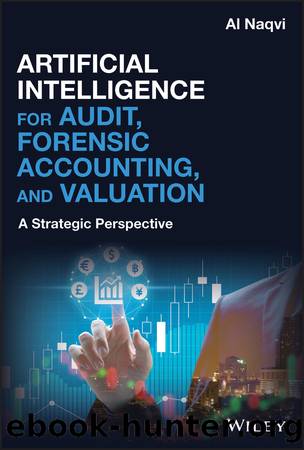Artificial Intelligence for Audit, Forensic Accounting, and Valuation by Naqvi Al;

Author:Naqvi, Al; [Naqvi, Al]
Language: eng
Format: epub
Publisher: John Wiley & Sons, Incorporated
Published: 2020-08-25T00:00:00+00:00
AUDITOR'S THOUGHT PROCESS
Based upon the various criteria presented in the previous section, the auditor makes assessments about the risk inherent in the assertions related to the financial statements of the auditee. As such, identifying and measuring inherent risk can be approached in terms of a risk identification, assessment, evaluation, and management problem.
Cognitively, therefore, the auditor processes information about the industry, the firm, and the firm's management team and practices, and all such information is intuitively, or mathematically, translated into a risk estimate (Peters et al., 1989). The measurement could be qualitatively determined and based upon auditor's experience or it can be estimated by applying very rigorous mathematical criteria. Regardless of how it is estimated or determined, the risk estimate can be viewed as the cumulative measurement of values of risk drivers.
Risk drivers are individual risks that collectively lead to the measure of the total audit risk. Recall that the risk manifests in the accounting system and eventually finds its way into the financial statements.
Breaking down the auditor's cognitive thinking, the risk assessment part implies that that auditor maps the financial statements to accounts and accounts to risk factors (Shailer et al., 1998). The risk factors, in this case, are based upon the economic and operating environment of the firm, upon industry dynamics, and upon the management decision‐making (Figure 8.2). More practically, for our purposes, the problem can be viewed as this: the inherent risk impacts the financial statements and comes from the accounting system and is driven by the risk factors that emanate in the nature and operations of the firm, and its management and industry, processes, and the transactions.
Thus, risk drivers are a function of business model, industry dynamics, regulatory changes, etc., and of the firm-specific dynamics and of the management.
Download
This site does not store any files on its server. We only index and link to content provided by other sites. Please contact the content providers to delete copyright contents if any and email us, we'll remove relevant links or contents immediately.
Zero to IPO: Over $1 Trillion of Actionable Advice from the World's Most Successful Entrepreneurs by Frederic Kerrest(4078)
Machine Learning at Scale with H2O by Gregory Keys | David Whiting(3666)
Harry Potter and the Goblet Of Fire by J.K. Rowling(3619)
Never by Ken Follett(3550)
Ogilvy on Advertising by David Ogilvy(3354)
Shadow of Night by Deborah Harkness(3184)
The Man Who Died Twice by Richard Osman(2824)
Book of Life by Deborah Harkness(2727)
My Brilliant Friend by Elena Ferrante(2707)
How Proust Can Change Your Life by Alain De Botton(2621)
0041152001443424520 .pdf by Unknown(2613)
Will by Will Smith(2595)
The Tipping Point by Malcolm Gladwell(2566)
How to Pay Zero Taxes, 2018 by Jeff A. Schnepper(2508)
Purple Hibiscus by Chimamanda Ngozi Adichie(2505)
Hooked: A Dark, Contemporary Romance (Never After Series) by Emily McIntire(2428)
Rationality by Steven Pinker(2159)
Borders by unknow(2122)
Daughter of Smoke and Bone by Laini Taylor(2086)
